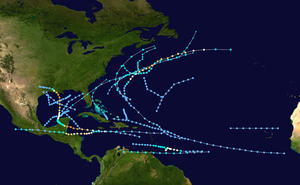| Timeline of the 1974 Atlantic hurricane season | |||||
|---|---|---|---|---|---|
 Season summary map | |||||
| Season boundaries | |||||
| First system formed | June 22, 1974 | ||||
| Last system dissipated | November 12, 1974 | ||||
| Strongest system | |||||
| Name | Carmen | ||||
| Maximum winds | 150 mph (240 km/h) (1-minute sustained) | ||||
| Lowest pressure | 928 mbar (hPa; 27.4 inHg) | ||||
| Longest lasting system | |||||
| Name | Carmen | ||||
| Duration | 12 days | ||||
| |||||
The 1974 Atlantic hurricane season was a cycle of the annual tropical cyclone season in the Atlantic Ocean in the Northern Hemisphere. There was near-average activity during the season,[nb 1] which officially began on June 1, 1974 and ended on November 30, 1974. These dates, adopted by convention, historically describe the period in each year when most tropical systems form.[2] The first system of the season, Tropical Depression One, formed on June 22. The final system of the season, Tropical Depression Seventeen, dissipated on November 11.
The 1974 season produced twenty tropical or subtropical depressions, of which eleven reached tropical (7) or subtropical (4) storm intensity. Four of the tropical storms became hurricanes, of which two became major hurricanes.[nb 2] At Category 4 on the Saffir–Simpson scale, Hurricane Carmen was the most intense tropical cyclone of the season. It threatened two densely populated areas during its duration, Belize City, Belize and New Orleans, Louisiana, but veered away at the last moment each time. Even so, the storm caused much flooding and crop damage in and around the Yucatán Peninsula and Gulf Coast of the United States.[4] The deadliest cyclone of 1974 was Hurricane Fifi (Category 2), which killed 6,000–8,000 people in Honduras, making it one of the deadliest Atlantic hurricanes on record.[5] As a result of their intensity and damage caused, the names Carman and Fifi were subsequently retired from reuse in the North Atlantic by the World Meteorological Organization.[6]
This timeline documents tropical cyclone formations, strengthening, weakening, landfalls, extratropical transitions, and dissipations during the season. It includes information that was not released throughout the season, meaning that data from post-storm reviews by the National Hurricane Center, such as a storm that was not initially warned upon, has been included.
By convention, meteorologists one time zone when issuing forecasts and making observations: Coordinated Universal Time (UTC), and also use the 24-hour clock (where 00:00 = midnight UTC).[7] In this time line, all information is listed by UTC first with the respective local time included in parentheses.
- ^ "Background Information: North Atlantic Hurricane Season". College Park, Maryland: NOAA Climate Prediction Center. Retrieved July 11, 2020.
- ^ Dorst, Neal (June 1, 2018). "Hurricane Season Information". Frequently Asked Questions About Hurricanes. Miami, Florida: NOAA Atlantic Oceanographic and Meteorological Laboratory. Retrieved June 29, 2020.
- ^ "Saffir-Simpson Hurricane Wind Scale". nhc.noaa.gov. Miami Florida: NOAA National Hurricane Center. Retrieved July 14, 2020.
- ^ Hope, John R. (April 1975). "Atlantic Hurricane Season of 1974". Monthly Weather Review. 103 (4). American Meteorological Society: 285–293. Bibcode:1975MWRv..103..285H. doi:10.1175/1520-0493(1975)103<0285:AHSO>2.0.CO;2. Retrieved July 14, 2020.
- ^ Rappaport, Edward N.; Fernandez-Partagas, Jose (May 28, 1995). "The Deadliest Atlantic Tropical Cyclones, 1492–1996". Updated April 22, 1997 by Jack Beven. Miami, Florida: NOAA National Hurricane Center. Retrieved July 14, 2020.
- ^ "Tropical Cyclone Naming History and Retired Names". miami, Florida: NOAA National Hurricane Center. Retrieved July 14, 2020.
- ^ "Understanding the Date/Time Stamps". miami, Florida: NOAA National Hurricane Center. Retrieved July 14, 2020.
Cite error: There are <ref group=nb> tags on this page, but the references will not show without a {{reflist|group=nb}} template (see the help page).